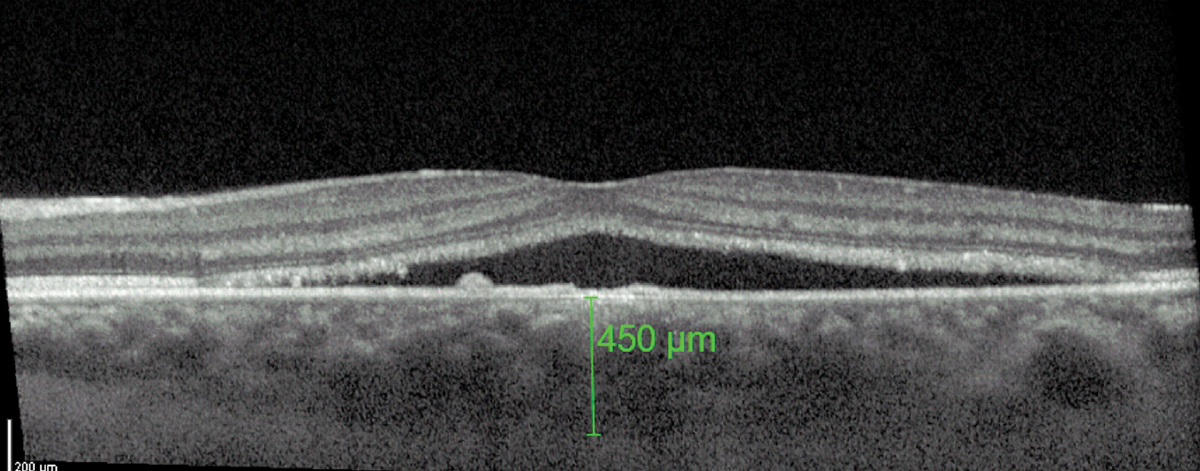 |
| Subretinal fluid resolution accompanied by rapid choroidal thinning can reflect the efficacy of spironolactone in those with a thick baseline choroid. Photo: Mohammad Rafieetary, OD. Click image to enlarge. |
Central serous chorioretinopathy (CSC) typically remains a long-term source of frustration for patients, given its recurrent and unpredictable nature, requiring timely intervention to preserve long-term visual outcomes. While there are current options of laser photocoagulation, photodynamic therapy, subthreshold micropulse lasers and various oral medications for CSC treatment, no consensus exists for managing non-resolving or chronic CSC.
However, spironolactone is the first steroidal mineralocorticoid receptor (MR) antagonist with a similar chemical structure to aldosterone and possesses competitive MR-blocking capabilities. Since CSC occurrence and development involves overactivation or inappropriate activation of the MR pathway, researchers of one new study wanted to evaluate the drug’s efficacy in treating chronic CSC cases, as well as to identify imaging characteristics that may predict if spironolactone would benefit a patient.
Included were 42 eyes of 42 chronic CSC patients who were given spironolactone 20mg TID and were followed for six months. A small majority ( 57.1%) of patients achieved complete resolution of subretinal fluid, while the mean subretinal fluid area, central macular thickness and subfoveal choroidal thickness all decreased significantly through the follow-up period; best-corrected visual acuity (BCVA) improved slightly. The vascular density of the choriocapillaris of fellow eyes did not vary during treatment.
After later analysis, it was revealed that subfoveal choroidal thickness and an intact ellipsoid zone were correlated with disease resolution, and a higher baseline subfoveal choroidal thickness was a predictive factor of responding well to treatment.
In their published paper on the work, the study authors highlight that oral MR antagonists like spironolactone may be a better option for those who are not suitable for (like those unable to identify leakage points or extensive subretinal fluids) or reject invasive treatments like photodynamic therapy or lasers. Additionally, this oral option is generally well-tolerated by patients with minimal occurrence of adverse effects.
The authors add that the high clinical rate of recurrence in chronic CSC patients indicates prolonged treatment is necessary for complete resolution of subretinal fluid accumulation. As well, the degree of diffuse damage of retinal pigment epithelium photoceptor cells at baseline is thought to indicate visual acuity prognosis. In this study, patients with poor baseline vision had varying degrees of subretinal fluid regression after six months, but BCVA didn’t improve in some patients because of diffuse damage to photoreceptor cells and outer retinal structure atrophy.
While good responders to the drug seemed to have better visual acuity and less fluid at baseline than nonresponders, this difference was not significant. However, the authors do note that “spironolactone might not always improve functional outcomes; rather, it appears to improve anatomical results and may have preventative effects in patients with long durations of chronic disease. Therefore, identifying potential imaging predictors that can predict a good response to spironolactone treatment is valuable.”
Explaining said predictors, “the baseline choroidal thickness and continuous ellipsoid zone seem to be useful imaging predictors for identifying chronic CSC patients who could have a potentially good response to spironolactone therapy.”
Gao S, Zhang Y, Zhang M. Efficacy and predictive factors of oral spironolactone treatment in chronic central serous chorioretinopathy. J Ophthalmol. March 18, 2024. [Epub ahead print]. |


